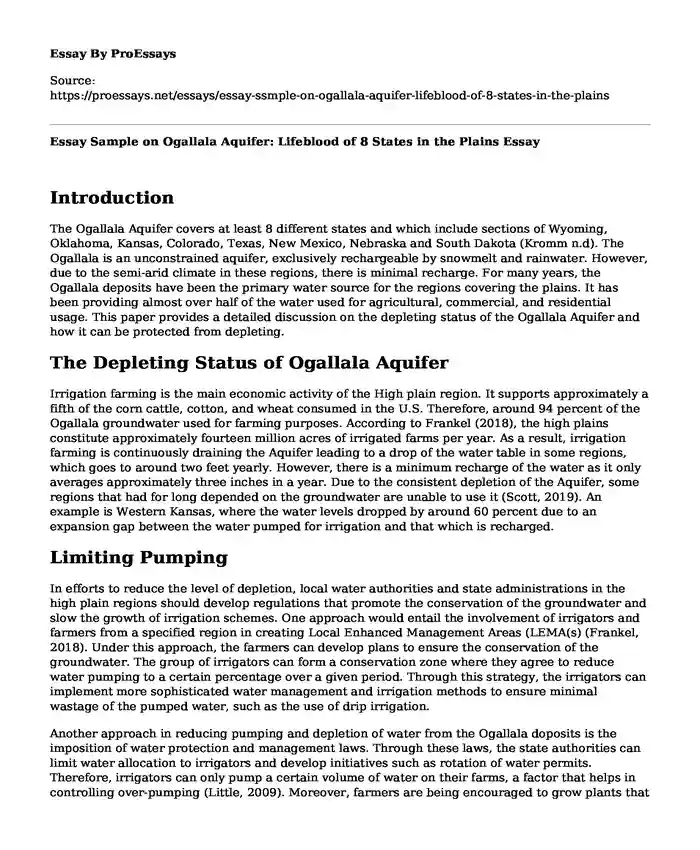Introduction
The Ogallala Aquifer covers at least 8 different states and which include sections of Wyoming, Oklahoma, Kansas, Colorado, Texas, New Mexico, Nebraska and South Dakota (Kromm n.d). The Ogallala is an unconstrained aquifer, exclusively rechargeable by snowmelt and rainwater. However, due to the semi-arid climate in these regions, there is minimal recharge. For many years, the Ogallala deposits have been the primary water source for the regions covering the plains. It has been providing almost over half of the water used for agricultural, commercial, and residential usage. This paper provides a detailed discussion on the depleting status of the Ogallala Aquifer and how it can be protected from depleting.
The Depleting Status of Ogallala Aquifer
Irrigation farming is the main economic activity of the High plain region. It supports approximately a fifth of the corn cattle, cotton, and wheat consumed in the U.S. Therefore, around 94 percent of the Ogallala groundwater used for farming purposes. According to Frankel (2018), the high plains constitute approximately fourteen million acres of irrigated farms per year. As a result, irrigation farming is continuously draining the Aquifer leading to a drop of the water table in some regions, which goes to around two feet yearly. However, there is a minimum recharge of the water as it only averages approximately three inches in a year. Due to the consistent depletion of the Aquifer, some regions that had for long depended on the groundwater are unable to use it (Scott, 2019). An example is Western Kansas, where the water levels dropped by around 60 percent due to an expansion gap between the water pumped for irrigation and that which is recharged.
Limiting Pumping
In efforts to reduce the level of depletion, local water authorities and state administrations in the high plain regions should develop regulations that promote the conservation of the groundwater and slow the growth of irrigation schemes. One approach would entail the involvement of irrigators and farmers from a specified region in creating Local Enhanced Management Areas (LEMA(s) (Frankel, 2018). Under this approach, the farmers can develop plans to ensure the conservation of the groundwater. The group of irrigators can form a conservation zone where they agree to reduce water pumping to a certain percentage over a given period. Through this strategy, the irrigators can implement more sophisticated water management and irrigation methods to ensure minimal wastage of the pumped water, such as the use of drip irrigation.
Another approach in reducing pumping and depletion of water from the Ogallala doposits is the imposition of water protection and management laws. Through these laws, the state authorities can limit water allocation to irrigators and develop initiatives such as rotation of water permits. Therefore, irrigators can only pump a certain volume of water on their farms, a factor that helps in controlling over-pumping (Little, 2009). Moreover, farmers are being encouraged to grow plants that require little irrigation to reduce water consumption from the Aquifer.
Conclusion
The Aquifer is depleting at a high rate. In a situation where it may go dry in the future, the United States will lose a lot in terms of food production and supply in the world market. Therefore, the state government and water authorities in the region should be accountable in developing strategies to reduce the level of pumping to ensure water availability in the future.
References
Frankel, J. (2018, May 17). Crisis on the high plains: The loss of America's largest Aquifer – the Ogallala. University of Denver Water Law Review at the Sturm College of Law. https://duwaterlawreview.com/crisis-on-the-high-plains-the-loss-of-americas-largest-aquifer-the-ogallala/
Kromm, D. E. (n.d.). Ogallala aquifer. Water Encyclopedia. https://www.waterencyclopedia.com/Oc-Po/Ogallala-Aquifer.html
Little, J. B. (2009, March 1). The Ogallala aquifer: Saving a vital U.S. water source. Scientific American. https://www.scientificamerican.com/article/the-ogallala-aquifer/
Scott, M. (2019, February 19). National climate assessment: Great Plains’ Ogallala aquifer drying out. NOAA Climate.gov. https://www.climate.gov/news-features/featured-images/national-climate-assessment-great-plains%E2%80%99-ogallala-aquifer-drying-out.
Cite this page
Essay Sample on Ogallala Aquifer: Lifeblood of 8 States in the Plains. (2023, Sep 17). Retrieved from https://proessays.net/essays/essay-ssmple-on-ogallala-aquifer-lifeblood-of-8-states-in-the-plains
If you are the original author of this essay and no longer wish to have it published on the ProEssays website, please click below to request its removal:
- Research Paper Sample on Organic Photovoltaic Devices - a Renewable Energy Source
- Managing Disaster Risk Through Climate Adaptation Paper Example
- Essay on Global Warming in Relation to Vegetarians
- Importance of Forests and Oceans Paper Example
- Research Paper on Climate-Change Policies for Low Carbon Transition
- Essay Example on Street Refuse: Composition & Sources of Pollution
- Research Paper on Clean Water: A Precious Resource for Human Survival







